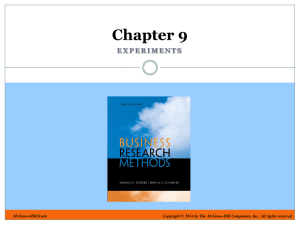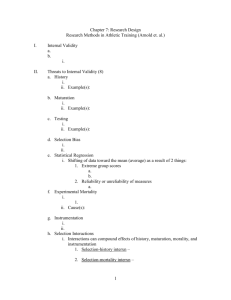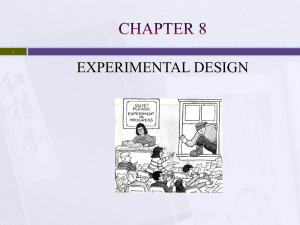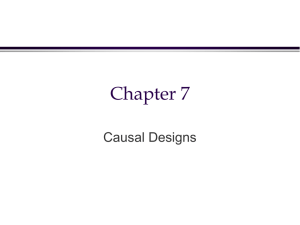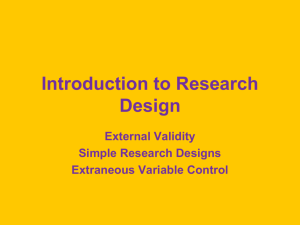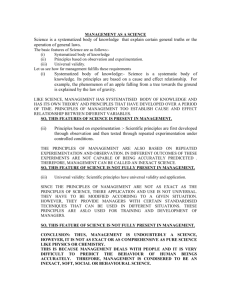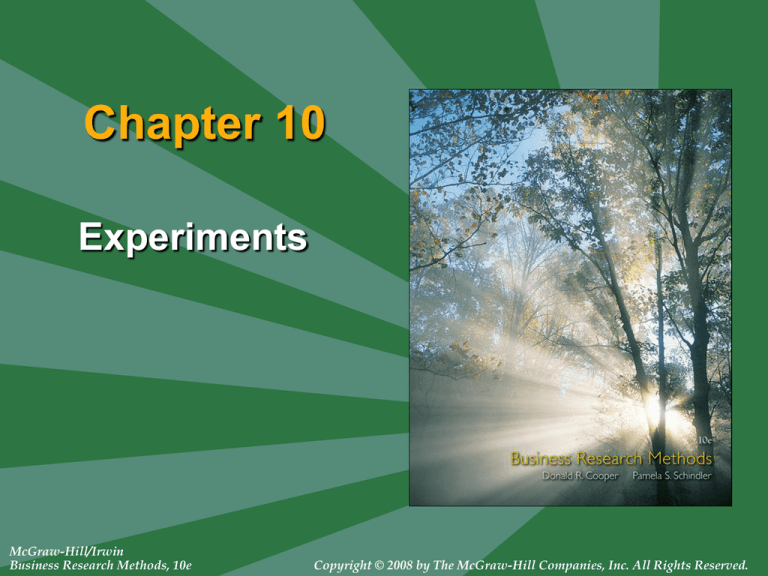
Chapter 10
Experiments
McGraw-Hill/Irwin
Business Research Methods, 10e
Copyright © 2008 by The McGraw-Hill Companies, Inc. All Rights Reserved.
10-2
Learning Objectives
Understand . . .
• Uses for experimentation.
• Advantages and disadvantages of the
experimental method.
• Seven steps of a well-planned experiment.
• Internal and external validity with
experimental research designs.
• Three types of experimental designs and
the variations of each.
10-3
Causal Evidence
Agreement between
IVs and DVs
Time order of occurrence
Extraneous variables
did not influence DVs
10-4
Causal Evidence
10-5
Evaluation of Experiments
Advantages
• Ability to manipulate
IV
• Use of control group
• Control of extraneous
variables
• Replication possible
• Field experiments
possible
Disadvantages
• Artificiality of labs
• Non-representative
sample
• Expense
• Focus on present and
immediate future
• Ethical limitations
10-6
Experimentation in the Research Process
10-7
Conducting an Experiment
Specify treatment variables
Specify treatment levels
Control environment
Choose experimental design
Select and assign participants
Pilot-test, revise, and test
Collect data
Analyze data
10-8
Experiment: Placement of Benefits Module
10-9
Selecting and Assigning Participants
Random
assignment
Matching
10-10
Random Assignment
10-11
Quota Matrix Example
10-12
Measurement Options
Observation
Physiological
measures
Paper-andpencil tests
Options
Scaling
techniques
Selfadministered
instruments
10-13
Validity in Experimentation
Internal
External
10-14
Threats to Internal Validity
Maturation
Experimental
mortality
History
Threats
Statistical
regression
Testing
Instrumentation
Selection
10-15
Additional Threats to Internal Validity
Diffusion of treatment
Compensatory equalization
Compensatory rivalry
Resentful disadvantaged
Local history
10-16
Threats to External Validity
Reactivity of
testing on X
Interaction of
selection and X
Other
reactive factors
10-17
Experimental Research Designs
Pre-experiments
True experiments
Field experiments
10-18
After-Only Case Study
X
Pre-experiment
O
10-19
One Group Pretest-Posttest Design
O1
Pre-experiment
X
O2
10-20
Static Group Comparison
X
O2
Pre-experiment
O1
10-21
Pretest-Posttest Control Group Design
R
True experiment
O1
R O3
X
O2
O4
10-22
Posttest-Only Control Group Design
R
R
True experiment
X
O1
O2
10-23
Nonequivalent Control Group Design
O1
O3
Field experiment
X
O2
O4
Separate Sample Pretest-Posttest
Design
R
R
Field experiment
O1
(X)
X
O2
10-24
10-25
Group Time Series Design
R
R
Field experiment
O1 O2 O3 X O4 O5 O6
O7 O8 O9 O10 O11 O12
10-26
Job Enrichment Quasi-Experiment
10-27
Experiment: Finding the Store Design
10-28
Experiment: The Right Size of Flavor
10-29
Key Terms
•
•
•
•
•
•
Blind
Control group
Controlled test market
Dependent variable
Double-blind
Environmental control
•
•
•
•
•
•
•
Experiment
Experimental treatment
External validity
Field experiment
Hypothesis
Independent variable
Internal validity
10-30
Key Terms
•
•
•
•
•
Matching
Operationalized
Quota matrix
Random assignment
Replication
• Test market
–
–
–
–
Electronic test market
Simulated test market
Standard test market
Virtual test market
• Treatment levels
• Web-enabled test market
10-31
Appendix 10b
Test Markets
McGraw-Hill/Irwin
Business Research Methods, 10e
Copyright © 2008 by The McGraw-Hill Companies, Inc. All Rights Reserved.
10-32
Test Market Selection
Over-testing
Control of
distribution
Representative
Criteria
Multiple
locations
Isolation
Media
coverage
10-33
Types of Test Markets
Standard
Controlled
Electronic
Simulated
Virtual
Web-enabled
10-34
Test Market Cities


